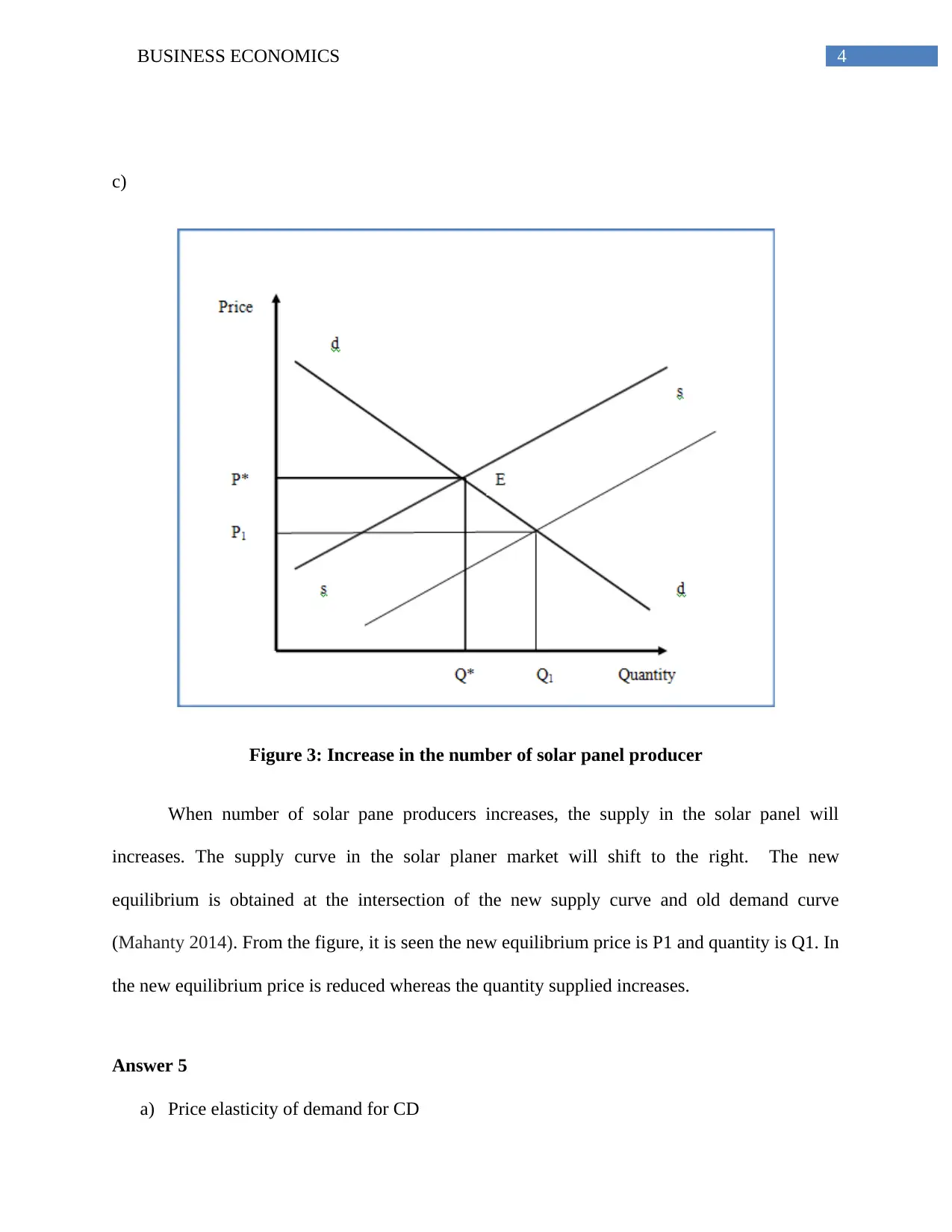Business Economics Assignment: Price Elasticity, Supply and Demand
VerifiedAdded on 2020/04/07
|7
|568
|155
Homework Assignment
AI Summary
This assignment analyzes the market dynamics of solar panels and electricity, exploring concepts like supply, demand, and price elasticity. The solution examines the impact of price changes on market equilibrium, including scenarios where the price of solar panels is above the equilibrium price, the effect of a fall in electricity prices, and the impact of increased solar panel production. The assignment also calculates the price elasticity of demand for CDs, concluding that a price reduction would be beneficial for the firms. References from Baumol and Blinder, Fine, Mahanty, and Moulin are included to support the analysis.

Running head: BUSINESS ECONOMICS
Business Economics
Name of the Student
Name of the University
Author note
Business Economics
Name of the Student
Name of the University
Author note
Paraphrase This Document
Need a fresh take? Get an instant paraphrase of this document with our AI Paraphraser

1BUSINESS ECONOMICS

2BUSINESS ECONOMICS
Answer 2
a)
Figure 1: Price of solar panel is above the equilibrium price
Market equilibrium is obtained when demand and supply curve cuts each other (Fine 2016). dd
and ss in the above figure represents the respective demand and supply curve in the market. P*
is Equilibrium price and Q* is the equilibrium quantity. Suppose now, price is above the
equilibrium price say at P1. At this price market supply exceed the market demand creating an
excess supply of the amount ab. For the excess quantity to be sold in the market price has to be
reduced and reaches to the equilibrium price.
Answer 2
a)
Figure 1: Price of solar panel is above the equilibrium price
Market equilibrium is obtained when demand and supply curve cuts each other (Fine 2016). dd
and ss in the above figure represents the respective demand and supply curve in the market. P*
is Equilibrium price and Q* is the equilibrium quantity. Suppose now, price is above the
equilibrium price say at P1. At this price market supply exceed the market demand creating an
excess supply of the amount ab. For the excess quantity to be sold in the market price has to be
reduced and reaches to the equilibrium price.
⊘ This is a preview!⊘
Do you want full access?
Subscribe today to unlock all pages.

Trusted by 1+ million students worldwide

3BUSINESS ECONOMICS
b)
Figure 2: Effect of a fall in price of electricity
The market for solar panel and electricity are substitutes. For, substitute goods a decrease
in the price of a good leads to an increase in own demand while reduces the demand for the
substitute good (Baumol and Blinder 2015). When price of electricity is decreased by 50% , then
people will use more electricity. Given price of solar panel, it seems costlier for consumers and
hence, they reduces the use of solar panel. As a result, the market demand curve of solar panel
shifts leftward. Both equilibrium price and quantity reduces in this situation. the new price is P1
and the new equilibrium quantity is Q1.
b)
Figure 2: Effect of a fall in price of electricity
The market for solar panel and electricity are substitutes. For, substitute goods a decrease
in the price of a good leads to an increase in own demand while reduces the demand for the
substitute good (Baumol and Blinder 2015). When price of electricity is decreased by 50% , then
people will use more electricity. Given price of solar panel, it seems costlier for consumers and
hence, they reduces the use of solar panel. As a result, the market demand curve of solar panel
shifts leftward. Both equilibrium price and quantity reduces in this situation. the new price is P1
and the new equilibrium quantity is Q1.
Paraphrase This Document
Need a fresh take? Get an instant paraphrase of this document with our AI Paraphraser

4BUSINESS ECONOMICS
c)
Figure 3: Increase in the number of solar panel producer
When number of solar pane producers increases, the supply in the solar panel will
increases. The supply curve in the solar planer market will shift to the right. The new
equilibrium is obtained at the intersection of the new supply curve and old demand curve
(Mahanty 2014). From the figure, it is seen the new equilibrium price is P1 and quantity is Q1. In
the new equilibrium price is reduced whereas the quantity supplied increases.
Answer 5
a) Price elasticity of demand for CD
c)
Figure 3: Increase in the number of solar panel producer
When number of solar pane producers increases, the supply in the solar panel will
increases. The supply curve in the solar planer market will shift to the right. The new
equilibrium is obtained at the intersection of the new supply curve and old demand curve
(Mahanty 2014). From the figure, it is seen the new equilibrium price is P1 and quantity is Q1. In
the new equilibrium price is reduced whereas the quantity supplied increases.
Answer 5
a) Price elasticity of demand for CD

5BUSINESS ECONOMICS
Price elastcity of demand= Percentage change ∈demand
Percentage chnge∈price
The estimated change in demand when average price of CD decreases from $21 to $21 is
40 percent
percentage change ∈price= 21−15
21 ∗100=28.57
Price elasticity of demand= 40
28.57 =1.40
b) Elasticity plays an important role in deciding the benefits that the firm is going to obtain
from price change. Revenue is price multiplied by quantity sold. Buyers are able to
change their demand to a greater proportion than price then, then demand is said to be
elastic (Moulin 2014 ). In this case, price reduction is beneficial for the firms, as they will
be benefitted more from the increased sale than loss from price reduction. The estimated
elasticity measure is 1.40. Since, the demand is elastic in nature a price cur is advisable
for Universal Music CD.
Price elastcity of demand= Percentage change ∈demand
Percentage chnge∈price
The estimated change in demand when average price of CD decreases from $21 to $21 is
40 percent
percentage change ∈price= 21−15
21 ∗100=28.57
Price elasticity of demand= 40
28.57 =1.40
b) Elasticity plays an important role in deciding the benefits that the firm is going to obtain
from price change. Revenue is price multiplied by quantity sold. Buyers are able to
change their demand to a greater proportion than price then, then demand is said to be
elastic (Moulin 2014 ). In this case, price reduction is beneficial for the firms, as they will
be benefitted more from the increased sale than loss from price reduction. The estimated
elasticity measure is 1.40. Since, the demand is elastic in nature a price cur is advisable
for Universal Music CD.
⊘ This is a preview!⊘
Do you want full access?
Subscribe today to unlock all pages.

Trusted by 1+ million students worldwide

6BUSINESS ECONOMICS
References
Baumol, W.J. and Blinder, A.S., 2015. Microeconomics: Principles and policy. Cengage
Learning.
Fine, B., 2016. Microeconomics. University of Chicago Press Economics Books.
Mahanty, A.K., 2014. Intermediate microeconomics with applications. Academic Press.
Moulin, H., 2014. Cooperative microeconomics: a game-theoretic introduction. Princeton
University Press.
References
Baumol, W.J. and Blinder, A.S., 2015. Microeconomics: Principles and policy. Cengage
Learning.
Fine, B., 2016. Microeconomics. University of Chicago Press Economics Books.
Mahanty, A.K., 2014. Intermediate microeconomics with applications. Academic Press.
Moulin, H., 2014. Cooperative microeconomics: a game-theoretic introduction. Princeton
University Press.
1 out of 7
Related Documents
Your All-in-One AI-Powered Toolkit for Academic Success.
+13062052269
info@desklib.com
Available 24*7 on WhatsApp / Email
![[object Object]](/_next/static/media/star-bottom.7253800d.svg)
Unlock your academic potential
Copyright © 2020–2026 A2Z Services. All Rights Reserved. Developed and managed by ZUCOL.




